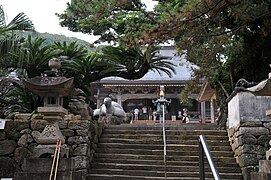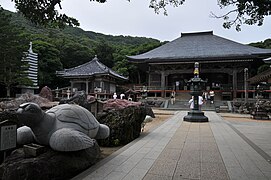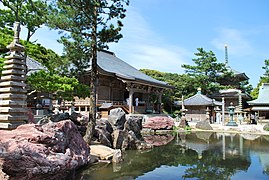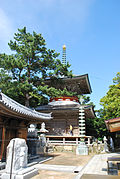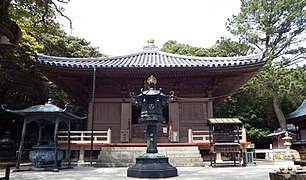Kongōfuku-ji
The Kongōfuku-ji ( Japanese 金剛福 寺 ), with the Go Sadazan (蹉跎 山) and Fudarakuin (補 陀 洛 院) in the city of Tosashimizu ( Kōchi Prefecture ), is a temple of the Buzan branch (豊 山 派) of Shingon Buddhism . In the traditional count, it is the 38th temple on the Shikoku pilgrimage route .
history
At the request of Emperor Saga , priest Kūkai built a temple at the southernmost point of Shikoku in Kōnin 13 (822) and made a three-faced Kannon as a cult figure for the place of prayer. He called the temple "Kongōfuku-ji", where Kongō is another word for Vajra , so for the club-shaped ritual object of Buddhism. Kūkai is said to have hurled such a club in the direction of Japan when he returned from Tang-era China . And “Fuku”, meaning luck or blessing, is a line from the Kannon Sutra: 福聚 海 無量 ( Fujujukai muryō ), which means “The accumulation of happiness is as immeasurable as the sea”.
In the following years the emperors supported the temple, including the military leaders. The Minamoto in particular were fond of the temple. So built Minamoto no Mitsunaka treasure pagoda and other buildings along with his son, took care of repairs.
From the end of the 16th century, the belief developed that in the distance behind the sea horizon lies a paradisiacal land, called Fudaraku Jōdo ( 補 陀 落 浄土 ). Perhaps one could row out from the temple and seek fortune there. The Tosa branch of the Ichijō and later the Yamanouchi supported the temple, the latter recognizable by the coat of arms of the Yamanouchi in various places in the temple: three oak leaves in a circle.
investment
You enter the temple on the hillside from the south through the temple gate, which is designed as a Niō gate (仁王 門, Niō-mon; 1), as a gate with space for the two temple guards to the right and left of the passage. At the bottom right of the pond there is a memorial stone for the “priest crossing the sea” (渡海 僧, Tokai-sō). You climb further up to the temple level and on the way straight to the main hall (本 堂, Hondō; 2) the so-called “priest turtle” (大師 亀, Daishi-Kame), made of large stone, is on the left in front of the pond.
To the right of the main hall is the Goma Hall (護 摩 堂; 3) and on the far right is the Treasure Pagoda (多 宝塔, Tahōtō; 4). To the left of the main hall are a number of small places of prayer, the Aizen Hall (愛 染; 5), the Gyōsha Hall (行者 堂; 6), the Gongen Hall (権 現 堂; 7), the Monjū Hall (文殊 堂; 8) and finally the larger hall, which is dedicated to the temple founder, the Daishidō (大師 堂; 9). Behind it is the guest house (G) of the temple. On the way there you have passed the newly built bell tower (鐘楼堂, Shōrōdō; 10) on the left. It is unusual for a temple to have the bell in a tower-like building.
Treasures
The three-faced Kannon is about 1.6 m high and is made of Hinoki wood. It is registered as a cultural asset of the prefecture.
photos
literature
- Kōchi-ken kotogakko kyoiku kenkyukai rekishi bukai (Ed.): Kongōfuku-ji . In: Kōchi-ken no rekishi sampo. Yamakawa Shuppan, 2006, ISBN 978-4-634-24639-3 , page 243.
- Oguri, Doei: Kukai. Shikoku hachijuhachi kosho no arukikata. Chukei no Bunko, 2011, ISBN 978-4-8061-4067-2 .
Web links
Coordinates: 32 ° 43 '33.7 " N , 133 ° 1' 6.8" E
← Previous Temple: Iwamoto-ji | Kongōfuku-ji | Next temple: Enkō-ji →


